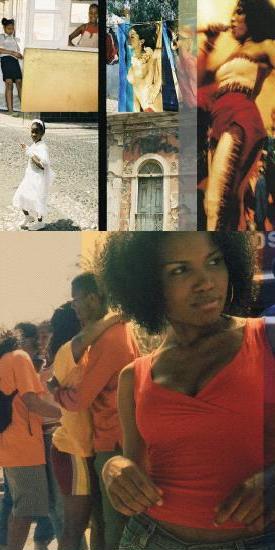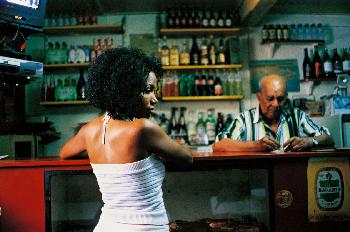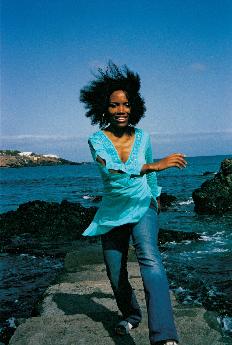

Capeverdean Singer
Lura
Portuguese singer
with capeverdean source
A burning voice providing us
with reasons to live ....
|
|

|


Lura
The country’s name is cape verde and the young woman is lura. She sings of this former portuguese
territory, a string of ten islands, ten volcanic pebbles scattered in the ocean off senegal. Connoisseurs
of diva cesaria evora are familiar with the little archipelago, insignificant in terms of global
strategy, but possessed of a native wisdom that could teach more powerful nations a great deal.
Invented by european colonists, tilled by transported africans and seared by drought, cape verde has
managed to heal the wounds inflicted by a history of famine and become a hospitable, peaceful,
proud country. Lura sings of this land, where she was not born…
Lura is as young as the country of her roots. Cape Verde
split away from Portugal in 1975, the year she was born in
Lisbon. Portugal’s capital is home to most of the Cape
Verdean diaspora, although large communities are also to
be found in Senegal, the north-east United States, Holland,
France and Italy. Two-thirds of Cape Verdeans live outside
their country and the same is true of their artists. In Lisbon,
the Cape Verdean population is mainly concentrated in the
suburb of Benfica, in a makeshift district of narrow streets
and jerry-built houses. However, the Portuguese-African
“centre” of Lisbon is Rua Poço de Negros (Well of the
Blacks Street), a long thoroughfare that runs from the historical
quarter of Bairro Alto to the Parliament district, and
holds many African restaurants, shops and nightclubs.
Lura’s father was from Santiago, the largest, greenest, most
African island of Cape Verde, and her mother from São
Nicolau, the island that produces the best grog (Cape
Verdean rum). “There was nothing artistic about my family,
my parents mainly listened to morna,” muses Lura,
recalling her early youth with an allusion to the velvet,
slightly mocking saudade that, lethargically intoned by
Cesaria Evora, has made Cape Verde famous all over the
world. “She has opened the way. Now we can present other
Cape Verdean styles,” explains Lura. Her body sculpted by
swimming, dancing and simply the desire to be beautiful,
the artist performs two or three of Cape Verde’s main genres.
|

Lura was a dancer when a singing star of African music in
Lisbon, Juka, originally from São Tome and Principe,
asked her to appear on his new album. “I was seventeen.
I was supposed to sing backing vocals, but soon Juka
asked me to perform a duet with him. I’d never thought
about singing, but he insisted,” she says. So Lura discovered
the potential of her voice, its deep timbre and sensual
inflections. Juka’s zouk was a hit and other Portuguesespeaking
African celebrities asked Lura to work with
them, among them Bonga from Angola and her fellow
countrymen Tito Paris, Paulo Florès and Paulinho Vieira.
Meanwhile, she was working with a theatre company as
she made her first album with a Portuguese producer: a
dance record for her generation featuring syrupy love zouk
and sugary r’n’b, Cape Verdean creole-style. “It was mainly
aimed at discotheques,” she explains. But despite the
album’s commercial recipes and tricks of the trade, the
song Nha Vida (My Life) attracted wider interest and was
featured on Red Hot + Lisbon, a compilation for the campaign
against AIDS, including songs by Brazilian stars
Caetano Veloso, Marisa Monte and Djavan, Bonga and
Teresa Salgueiro, the singer of Portuguese group
Madredeus. At the time, Lura was 21.
Having discovered the young prodigy when she sang a
duet with Bonga – Mulemba Xangola – Lusafrica produced
her second album in 2002. “The record was chiefly
aimed at the community’s young people,” the singer says.
In other words, it was a cocktail of r’n’b and zouk, the
latest craze among Cape Verdean youth. But practised ears
picked out two tracks of special worth: Ma'n ba dès bès
kumida dâ and Tabanka Assigo, a pair of songs written by
the young Tcheka that offer a lingering essence of Cape
Verdean music, delicious rhythms sung by a mature,
voluptuous voice.
It was not until 2004 that Lura made a truly Cape Verdean
record: Di Korpu Ku Alma (Of Body and Soul), whose
reputation was boosted in the country and among the diaspora
by the success of Vazulina, a story of petroleum-jelly
abuse among Africans bent on straightening their hair. The
song’s subject is very much a declaration of Cape Verdean
identity. It was penned by Orlando Pantera (as were Na Ri
Na, Es Bida, Batuku and Raboita di Rubon Manel), a
young writer who revolutionised one of Cape Verde’s great
traditional genres before his death, establishing a style that
inspired an entire generation of new artists.
In 2005 Di Korpu Ku Alma is being reissued with four previously
unreleased songs (and a DVD). The album especially
provides a new take on the old batuque beat, rapped
out by the washerwomen of Santiago on bundles of cloth
(tchabeta) held in their laps. With a slight catch in her mellow
voice, Lura leads them out into the world…
|

LURA’s LIGHT
from a biography by José Eduardo Agualusa
(translated from Portuguese)
The voice on this album is among those I have
believed in most strongly over the last few years.
Ever since I heard Nha Vida, I have been telling
anyone who cares to listen that the future of Cape
Verdean music already has a name: Lura.
Some shadows shine with their own light. Those that
form this song, for instance. A smoothly burning
voice, at once sweet and caustic, providing us with
reasons to live. A voice we want to hear on both
joyful and sad occasions. A voice that soothes us and
sweeps us away.
 “Listen to Lura,” I repeated endlessly, even to those
sceptics who pointed out past misjudgements in the
young singer’s career. Nha Vida rescued the
eponymous album (her first) released in Lisbon on
the 31st July 1996, her 21st birthday. The following
year, the track was chosen for the Onda Sonora Red
Hot + Lisbon compilation. Lura’s extraordinary voice
shines with the dazzling sheen of newly-polished
metal among the others on this record, which includes
some of the greatest performers in the vast
Portuguese-speaking world: Marisa Monte, Caetano
Veloso, Teresa Salgueiro, Filipa Pais, Djavan and
Bonga.
“Listen to Lura,” I repeated endlessly, even to those
sceptics who pointed out past misjudgements in the
young singer’s career. Nha Vida rescued the
eponymous album (her first) released in Lisbon on
the 31st July 1996, her 21st birthday. The following
year, the track was chosen for the Onda Sonora Red
Hot + Lisbon compilation. Lura’s extraordinary voice
shines with the dazzling sheen of newly-polished
metal among the others on this record, which includes
some of the greatest performers in the vast
Portuguese-speaking world: Marisa Monte, Caetano
Veloso, Teresa Salgueiro, Filipa Pais, Djavan and
Bonga.
Lura’s new album, Di Korpo ku Alma (Of Body and
Soul) fully justifies my most optimistic predictions.
The future is here. In passing, I should confess that I
had no difficulty in prophesying Lura’s future. My
only real surprise was that no-one else saw what is
becoming very obvious today.
 “Listen to Lura.” First, listen to the powerful Batuku
that opens body and soul. This theme by the late
lamented Orlando Pantera – whose spirit shines all
through this record – seems tailored to match Lura’s
energy. Batuku is in fashion, she sings. Well, if it
wasn’t already, it will be now. Four more of Pantera’s
songs feature on this CD: Na Ri Na, Vazulina, Es
Bida and Raboita di Rubon Manel – from everyday
satire (the wonderful Vazulina) to a eulogy to
rebellion. Lura, one of the few female songwriters in
the sumptuous world of Creole music, penned several
songs in the album. On So Um Cartinha (Just a little
letter), she pokes fun at a typically Cape Verdean
custom of asking family or friends who are visiting
Lisbon to take back “a little letter”, then presenting
them with a fully-packed trunk. With pianist
Fernando Andrade, she also wrote the emblematic
Mundó Ê Nos and Oh Náia, together with the fine
Tem um Hora pa Tude (There’s a time for everything),
based – so she says – on a tour of various North
European countries with Cesaria Evora in June 2003.
“Listen to Lura.” First, listen to the powerful Batuku
that opens body and soul. This theme by the late
lamented Orlando Pantera – whose spirit shines all
through this record – seems tailored to match Lura’s
energy. Batuku is in fashion, she sings. Well, if it
wasn’t already, it will be now. Four more of Pantera’s
songs feature on this CD: Na Ri Na, Vazulina, Es
Bida and Raboita di Rubon Manel – from everyday
satire (the wonderful Vazulina) to a eulogy to
rebellion. Lura, one of the few female songwriters in
the sumptuous world of Creole music, penned several
songs in the album. On So Um Cartinha (Just a little
letter), she pokes fun at a typically Cape Verdean
custom of asking family or friends who are visiting
Lisbon to take back “a little letter”, then presenting
them with a fully-packed trunk. With pianist
Fernando Andrade, she also wrote the emblematic
Mundó Ê Nos and Oh Náia, together with the fine
Tem um Hora pa Tude (There’s a time for everything),
based – so she says – on a tour of various North
European countries with Cesaria Evora in June 2003.
 Another name to remember is Tcheka. This rising
young star in the islands’ musical firmament plays on
two memorable tracks: Tabanka Assigo and Ma´n ba
dês bês kumida dâ. The CD also features an old
Bulimundo song, Tó Martins, which is about
emigration, a recurring theme in the music of this
historic group, and Padoce di Céu Azul by Valdemiro
Ferreira (Vlu), previously recorded by Tito Paris on
his Guilhermina album.
Another name to remember is Tcheka. This rising
young star in the islands’ musical firmament plays on
two memorable tracks: Tabanka Assigo and Ma´n ba
dês bês kumida dâ. The CD also features an old
Bulimundo song, Tó Martins, which is about
emigration, a recurring theme in the music of this
historic group, and Padoce di Céu Azul by Valdemiro
Ferreira (Vlu), previously recorded by Tito Paris on
his Guilhermina album.
“Listen to Lura.” And then go and see her on stage,
plunging herself body and soul into her art, pure
Creole beauty with a startling voice. Although she
says that her theatrical experience with the Plano Seis
company has helped her greatly on stage, I am still
convinced that her basic performing talent is innate.
It mainly lies in her passion and youthful energy, and
– of course – the fantastic power of her truly unique
voice, a gift she took years to accept. “I thought my
voice was awful,” she says. “I was even ashamed to
sing Happy Birthday.” Born in Lisbon in 1975, she
discovered her Cape Verdean identity (while
remaining fully Portuguese) through the Creole she
learnt with her friends at school. Today, she is proud
to speak and write her songs in a deep Creole from
the heart of the islands. As a child, she wanted to be a
dancer. Later, she taught swimming. Finally, music
drew her from the water. Unlucky for her pupils, but
very fortunate for all of us who listen to her today.
Once, when the world was still limitless and
enigmatic, nervous cartographers noted the legend
“here be dragons” on the edges of their maps. As I
look into the future – just as those ancient
cartographers looked at the world – I can confidently
write on Lura’s map “here be great light: the radiance
of a great singer”.
Thank you, Lura.
José Eduardo Agualusa
|

PLANING CONCERTS
marketing & promotion:
(33) 01 41 83 66 30 / lusafrica@lusafrica.com
LURA (Cap-Vert / Cabo Verde)
05-02/10 @ Alhambra, Paris FRANCE
13-02/10 @ St Pölten, Austria
11-03/10 @ Bruxelles, Belgique
25-03/10 @ Vigo, Espagne
21-04/10 @ Centro de Congressos, Lisboa Portugal
23-04/10 @ Sao Paulo, Brazil (w/ Adriana Calcanhoto)
24-04/10 @ Sao Paulo, Brazil (w/ Misia)
12-05/11 @ Vienna, Austria
|

LUSAFRICA - AFRICA NOSTRA
115 rue Lamarck
75018 PARIS FRANCE
| |
tel. : +33 (0)1 53 11 19 06
+33 (0)1 53 11 19 05
|
lusafrica@lusafrica.com - www.lusafrica.com









 Capeverdean Music
Capeverdean Music  “Listen to Lura,” I repeated endlessly, even to those
sceptics who pointed out past misjudgements in the
young singer’s career. Nha Vida rescued the
eponymous album (her first) released in Lisbon on
the 31st July 1996, her 21st birthday. The following
year, the track was chosen for the Onda Sonora Red
Hot + Lisbon compilation. Lura’s extraordinary voice
shines with the dazzling sheen of newly-polished
metal among the others on this record, which includes
some of the greatest performers in the vast
Portuguese-speaking world: Marisa Monte, Caetano
Veloso, Teresa Salgueiro, Filipa Pais, Djavan and
Bonga.
“Listen to Lura,” I repeated endlessly, even to those
sceptics who pointed out past misjudgements in the
young singer’s career. Nha Vida rescued the
eponymous album (her first) released in Lisbon on
the 31st July 1996, her 21st birthday. The following
year, the track was chosen for the Onda Sonora Red
Hot + Lisbon compilation. Lura’s extraordinary voice
shines with the dazzling sheen of newly-polished
metal among the others on this record, which includes
some of the greatest performers in the vast
Portuguese-speaking world: Marisa Monte, Caetano
Veloso, Teresa Salgueiro, Filipa Pais, Djavan and
Bonga.
 “Listen to Lura.” First, listen to the powerful Batuku
that opens body and soul. This theme by the late
lamented Orlando Pantera – whose spirit shines all
through this record – seems tailored to match Lura’s
energy. Batuku is in fashion, she sings. Well, if it
wasn’t already, it will be now. Four more of Pantera’s
songs feature on this CD: Na Ri Na, Vazulina, Es
Bida and Raboita di Rubon Manel – from everyday
satire (the wonderful Vazulina) to a eulogy to
rebellion. Lura, one of the few female songwriters in
the sumptuous world of Creole music, penned several
songs in the album. On So Um Cartinha (Just a little
letter), she pokes fun at a typically Cape Verdean
custom of asking family or friends who are visiting
Lisbon to take back “a little letter”, then presenting
them with a fully-packed trunk. With pianist
Fernando Andrade, she also wrote the emblematic
Mundó Ê Nos and Oh Náia, together with the fine
Tem um Hora pa Tude (There’s a time for everything),
based – so she says – on a tour of various North
European countries with Cesaria Evora in June 2003.
“Listen to Lura.” First, listen to the powerful Batuku
that opens body and soul. This theme by the late
lamented Orlando Pantera – whose spirit shines all
through this record – seems tailored to match Lura’s
energy. Batuku is in fashion, she sings. Well, if it
wasn’t already, it will be now. Four more of Pantera’s
songs feature on this CD: Na Ri Na, Vazulina, Es
Bida and Raboita di Rubon Manel – from everyday
satire (the wonderful Vazulina) to a eulogy to
rebellion. Lura, one of the few female songwriters in
the sumptuous world of Creole music, penned several
songs in the album. On So Um Cartinha (Just a little
letter), she pokes fun at a typically Cape Verdean
custom of asking family or friends who are visiting
Lisbon to take back “a little letter”, then presenting
them with a fully-packed trunk. With pianist
Fernando Andrade, she also wrote the emblematic
Mundó Ê Nos and Oh Náia, together with the fine
Tem um Hora pa Tude (There’s a time for everything),
based – so she says – on a tour of various North
European countries with Cesaria Evora in June 2003. Another name to remember is Tcheka. This rising
young star in the islands’ musical firmament plays on
two memorable tracks: Tabanka Assigo and Ma´n ba
dês bês kumida dâ. The CD also features an old
Bulimundo song, Tó Martins, which is about
emigration, a recurring theme in the music of this
historic group, and Padoce di Céu Azul by Valdemiro
Ferreira (Vlu), previously recorded by Tito Paris on
his Guilhermina album.
Another name to remember is Tcheka. This rising
young star in the islands’ musical firmament plays on
two memorable tracks: Tabanka Assigo and Ma´n ba
dês bês kumida dâ. The CD also features an old
Bulimundo song, Tó Martins, which is about
emigration, a recurring theme in the music of this
historic group, and Padoce di Céu Azul by Valdemiro
Ferreira (Vlu), previously recorded by Tito Paris on
his Guilhermina album.

